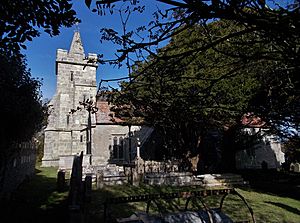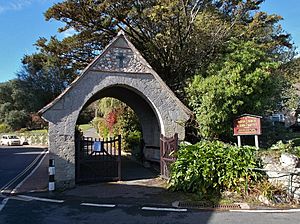Church of St John the Baptist, Niton facts for kids
Quick facts for kids Church of St John the Baptist, Niton |
|
|---|---|
 |
|
| Denomination | Church of England |
| Churchmanship | Broad Church |
| History | |
| Dedication | St John the Baptist |
| Administration | |
| Parish | Niton, Isle of Wight |
| Diocese | Portsmouth |
| Province | Canterbury |
The Church of St John the Baptist is a historic church located in Niton, Isle of Wight. It is a Church of England parish church, which means it serves the local community. This beautiful church is dedicated to St John the Baptist.
Contents
History of the Church Building
This church was first built a very long time ago. It was founded by a powerful person named William FitzOsbern. He gave the church to a monastery in Normandy, France. During the Victorian era (from 1837 to 1901), the church was greatly repaired and rebuilt. This is called a Victorian restoration.
Early Design and Changes
The main part of the church, called the nave, might be from the 11th century. The Norman font, used for baptisms, could also be from this time. A side section, known as a north aisle, was added around the end of the 12th century. A south aisle was built soon after.
In the 14th century, the chancel (the area around the altar) was rebuilt. A south porch, which is a covered entrance, was also added. In the 15th century, a small chapel was built south of the chancel. It was connected to the south aisle. A special arch was put in the chancel wall to link it with this new chapel.
Later Additions and Features
The north aisle was later taken down. The arches that connected it to the main church were filled in. New windows with two lights (sections) were put into these filled-in arches. These windows are in the Perpendicular Gothic style.
Towards the end of the 15th century, a tall west tower was added. This tower is also in the Perpendicular Gothic style. In the 16th century, square-shaped windows were put into the south aisle. The pointed top part of the tower, called a spire, was likely added in the early 17th century.
Inside the Church
Inside the church, you can find a special memorial. It is a portrait made by the artist John Flaxman. It shows a woman holding pelicans. The chancel has a modern reredos, which is a decorated screen behind the altar.
Royal Visitor and Important Graves
The church records, which go back to 1560, have an interesting entry. It says that on July 1, 1675, King Charles II landed safely at Puckaster. This happened after he survived a big and dangerous storm at sea.
Outside the church, in front of the porch, there is a 19th-century Celtic cross. It was designed by Joseph Clarke. This cross stands on the old steps of the churchyard cross.
Near the Celtic cross, there is a marble monument. It marks the grave of Edward Edwards (1812–1886). He was a very important person who helped start public libraries. The churchyard also has four graves for military personnel. These are called Commonwealth war graves. Three are from World War I and one is from World War II.
Church Organ Details
If you are interested in the church's organ, you can find more information. Details about the organ are available on the National Pipe Organ Register website.


